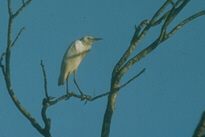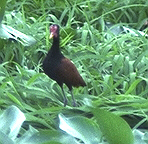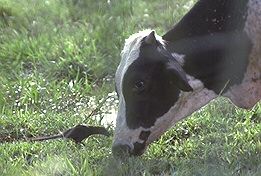Introduction  The interior of Suriname is covered with forests and there are some savanna areas. The northern part of the country is where most people live. There are many places to visit that are easily accessible and have a rich avifauna. The total number of bird species known from Suriname is 720+. First described below are some birds from the different regions of Suriname. The different species that are chosen, are mostly common in their habitat and can be easily spotted. Some are special birds that are nowhere as easily seen as in Suriname The birds are described on separate pages and are illustrated with a picture. Then follow some remarks on endangered birds species.
The interior of Suriname is covered with forests and there are some savanna areas. The northern part of the country is where most people live. There are many places to visit that are easily accessible and have a rich avifauna. The total number of bird species known from Suriname is 720+. First described below are some birds from the different regions of Suriname. The different species that are chosen, are mostly common in their habitat and can be easily spotted. Some are special birds that are nowhere as easily seen as in Suriname The birds are described on separate pages and are illustrated with a picture. Then follow some remarks on endangered birds species.
The coast 
Along the coast Suriname has a lot of mudflats, the mud coming from the Amazone and local rivers. With low tide they furnish a lot of food like small fish and crustaceans for herons, ibises and many small waders. Good places for birdwatching are those places where roads come near the seaborder: the sea wall at Nickerie, in Totness and Weg naar Zee near Paramaribo. The most splendid birds are the Scarlet ibises. Special is the Rufous Crab-hawk.
The richness of the mudflats brings in hundreds of thousands of small wading birds every year from North america as Suriname is an important stop for more than 20 species of wader. There are also some sandy beaches along the coast, for instance at the nature reserve of Wia-Wia, where seaturtles lay their eggs.
The mangrove forests and the swamps 
Just inside the coast are the black mangrove, Avicenna germinans, forests. They are important breeding places for ibises and herons. Because of the musquitos, watching birds here is not always pleasant.
Vast parts of the coastal plain are always or often submerged. The main road from Nickerie to Albina has large tracks through such country. Right along the coast are the salt lagoons and brackish swamps. More inland are the freshwatermarshes, vast areas of these have been converted to rice fields. A conspicious bird here is the Wattled jacana . Dry places in the marshes can be found on shell ridges. Outside the cultivated areas they are covered with high bush, a good place to search for toucans . Everywhere along watercourses you can hear the Yellow-throated spinetail with its long trembling notes. Its nest is a conspicous ball of dried grass. Along the waterside in dense vegetation you find the solitary Striated heron, looking out for fish with a curved neck.
The cultivated areas 
The easiest way to see birds is to look for them in the residence areas and the cultivated parts of Suriname. In the rice fields of Nickerie and Coronie you can find the Snail kite. In trees near the fields he will use his curved bill to get large snails out of their shells and underneath a heap of shells will collect.
On the road to Coronie you can see the Yellow-headed caracara eating animals that were run over by traffic. In the trees along the road a Tropical kingbird will sit still, untill it flies away to catch an insect.
Between cows there are Cattle egrets and Smooth-billed anis looking for grasshoppers. Eating from all the plenitude of insects in the grass are also small birds like the Red-breasted blackbird and the Blue-black grassquit. Above the grass a Fork-tailed flycatcher flies with a tail that opens and closes like scissors hunting for flying insects. In longer grass a Variable seedeater searches for seads to crunch with its strong bill.
Black vultures you can find on the mountains of waste outside the city limits, but also on the roofs of houses or buildings. When a dark raincloud comes, you can see them gliding in circles high above the town in large numbers.
In isolated trees in open fields hang the nests of crested oropendolas [ponpon] or you can hear a noisy colony of Yellow-rumped caciques. On a telephone wire a Striped cuckoo calls its Surinamese name while he shakes his tail. On the same wires assemble from september to april large numbers of Barn swallows. Large flocks of these bird can be seen migrating on some days or feeding in the air on others.
The gardens Most birds described in this booklet have been chosen because they are easiliy spotted in the gardens. On the ground walks a pair of scaly ground-doves [stondoifi], while nodding their heads. On flowers are feeding black-throated mangos and bananaquits . A flock of green-rumped parrotlets flies over screeching. In a tree are an arrowhead piculet and a common tody-flycatcherseaking for insects. Building its nest sometimes in a room of your house is a house wren. In shrubs you can hear the barred antshrike with its characteristic sound ko,ko,ko,ko,ko,ko,ko, krr. Eating mango and papaya is a blue tanager. Just outside on the street is a tropical mockingbird and a great kiskadee is calling its name from a telephone wire.
At night a white shadow flies through the streets, a barn owl. Some people (and may be mice) get goose pimples from its harsh cries.
In gardens farther away from the town center a violaceous euphonia is singing its high pitched melody in a high tree. On a lower level a pale breasted thrush [boontjedief] is whistling, along with shiny cowbirds and silver-beaked tanagers. At dawn you can listen quite some time before the heat of the day silences them.
Savanna 
A savanna belt crosses Suriname from east to west. In the west it runs at about 100 km from the coast, in the east near Albina much closer to it. From Paramaribo, the airport Zanderij is 40 km south. It is built in a region with savanna forests and white sand savannas. Deeper within the country there are several isolated savannas and in the south on the border with Brazil, is the Sipaliwini savanna, in a second belt that runs through Guyana to Venezuela. Zanderij is easy to reach and around the airport there are many good opportunities for birding. About 230 species of bird have been seen here. Some have been mentioned in the text above.The most conspicious birds are the large seed and fruiteaters. Parrots like orange-winged amazons and toucans, like the red-billed toucan, make a lot of noise. (Call from a channel-billed toucan).
Smaller fruiteaters like the tanagers, are easily seen in the trees. Numerous are the noisy silver-beaked tanagers. The picture at right is a violaceous euphonia, rather common in savanna trees. Around flowers you can find honeycreepers, hummingbirds and the bananaquit. Small seedeaters like the variable seedeater and the blue-black grassquit clamp to tall grasses. Hunting for insects in the air in daytime are swallows, at night many nightjars. From branches the kiskadee and the tropical kingbird fly short distances to catch their prey and low in the bushes and on the ground antbirdslook for insects. Very noisy are the troupials, like the crested oropendola and yellow-rumped cacique, that eat insects, fruit and small animals.
Rainforest 
A large part of Suriname is covered with forest, a continuation of the Amazonian rainforest. From the northern savanna belt to the savanna region in the south only forest is found, with rare open places, mostly for small villages along the rivers. Large tracks of land are unhabitated and unspoiled. One of the most beautiful places is the Raleigh Falls nature reserve, with more than 400 species of birds and many mammals. And the forest near the Voltzberg is even richer than the rest of the reserve in monkeys and birds. Among the 19 species of parrots here, are theblue-and-yellow macaw and the scarlet macaw.
Among the 45 species of birds of prey in Suriname, many can be seen in the Raleigh falls nature reserve. The largest is the harpy eagle. It eats monkeys and sloths out of the trees. A little bit less imposing is the ornate hawk-eagle, seen by P. Trail to eat the magnificent Cock-of-the-rock near the Voltzberg. Smaller prey is eaten by the red-throated caracara (wasps) and the bat falcon, that hunts on bats from branches on dead trees
Big gallinaceous birds mainly eat vegetable food like seeds and fruit. They are mostly seen in undisturbed forest. Now that hunting has stopped for some years on the Brownsberg you can see black curassows walking on the small roads. With a little bit of luck you see a marail guan in a tree or a group of grey-winged trumpeters searching for food between the trees.
Just as on the savanna there are many toucans around.
Many smaller birds are mainly heard. Among them many antbirds hunting for insects (not ants). Really interesting is the arrival of a column of army ants on your path. Stand still and you see too many species of birds to identify them all. They hunt for the insects that are fleeing the ants and as the ants move on so, do the birds; in a quarter of an hour all is quiet again.
Sipaliwini savanna 
The Sipaliwini savanna in the south has many birds that are seldom seen in the rest of Suriname. Many of the above mentioned birds are also known from the Sipaliwini: more than 300 species have been seen on this savanna, that is part of a bigger savanna in Brazil..
Where to look for special birds? A bird that is probably only around in Suriname is the Arrowhead piculet, a little woodpecker that is common in the Cultuurtuin and in Peperpot, both near the centre of Paramaribo.
The following birds are restricted to Suriname and parts of the Guyana shield, with between brackets a good place to look or listen for them: Blackish Antbird (Peperpot), Rufous Crab-hawk (Weg naar Zee), Band-tailed antshrike (Brownsberg, Raleighfalls and Palumeu), Blood-colored Woodpecker (around Paramaribo), White-thoated Pewee (Brownsberg), Pale-bellied mourner (around Zanderij airport).
For the Bronzy Jacamar, Saffron-crested Tyrant-Manakin and the Black Manakin, Suriname is probably the best place to look for them, especially in the low bushes on sandy ground near Zanderij airport. |


 The interior of Suriname is covered with forests and there are some savanna areas. The northern part of the country is where most people live. There are many places to visit that are easily accessible and have a rich avifauna. The total number of bird species known from Suriname is 720+. First described below are some birds from the different regions of Suriname. The different species that are chosen, are mostly common in their habitat and can be easily spotted. Some are special birds that are nowhere as easily seen as in Suriname The birds are described on separate pages and are illustrated with a picture. Then follow some remarks on endangered birds species.
The interior of Suriname is covered with forests and there are some savanna areas. The northern part of the country is where most people live. There are many places to visit that are easily accessible and have a rich avifauna. The total number of bird species known from Suriname is 720+. First described below are some birds from the different regions of Suriname. The different species that are chosen, are mostly common in their habitat and can be easily spotted. Some are special birds that are nowhere as easily seen as in Suriname The birds are described on separate pages and are illustrated with a picture. Then follow some remarks on endangered birds species.





